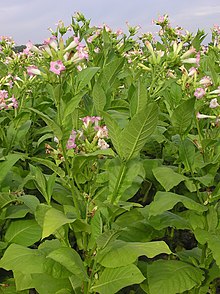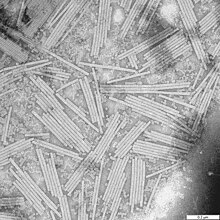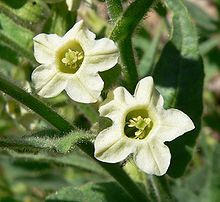Nicotiana
| Nicotiana | |
|---|---|

| |
| Flowering Nicotiana tabacum | |
| Scientific classification | |
| Kingdom: | |
| (unranked): | |
| (unranked): | |
| (unranked): | |
| Order: | |
| Family: | |
| Subfamily: | |
| Tribe: | |
| Genus: | Nicotiana |
| Species | |
|
Numerous, see text | |
| Synonyms | |
|
Amphipleis Raf. | |
Nicotiana (/[invalid input: 'icon']ˌnɪk[invalid input: 'ɵ']ʃiˈeɪnə/)[3] is a genus of herbaceous plants and shrubs of the family (Solanaceae) indigenous to the Americas, Australia, south west Africa and the South Pacific. Various Nicotiana species, commonly referred to as tobacco plants, are cultivated as ornamental garden plants. (N. tabacum) is grown worldwide for production of tobacco leaf for cigarettes and other tobacco products.
Etymology
The word nicotiana (as well as nicotine) was named in honor of Jean Nicot, French ambassador to Portugal, who in 1559 sent it as a medicine to the court of Catherine de' Medici.[4]
Cultivation
Several species of Nicotiana are grown as ornamental plants. They are popular vespertines, their sweet-smelling flowers opening in the evening to be visited by hawkmoths and other pollinators. The hybrid cultivars Domino Series [5] and 'Lime Green'[6] have gained the Royal Horticultural Society's Award of Garden Merit.
Ecology


Despite containing enough nicotine and/or other compounds such as germacrene and anabasine and other piperidine alkaloids (varying between species) to deter most herbivores,[7] a number of such animals have evolved the ability to feed on Nicotiana species without being harmed. Nonetheless, tobacco is unpalatable to many species and therefore some tobacco plants (chiefly Tree Tobacco, N. glauca) have become established as invasive species in some places.
In the nineteenth century, young tobacco plantings came under increasing attack from flea beetles (Epitrix cucumeris and/or Epitrix pubescens), causing destruction of half the United States tobacco crop in 1876. In the years afterward, many experiments were attempted and discussed to control the flea beetle. By 1880, it was discovered that replacing the branches with a frame covered by thin fabric would effectively protect plants from the beetle. This practice spread until it became ubiquitous in the 1890s.
Lepidoptera whose caterpillars feed on Nicotiana include:
- Dark Sword-grass or Black cutworm, Agrotis ipsilon
- Turnip Moth, Agrotis segetum
- Mouse Moth, Amphipyra tragopoginis
- The Nutmeg, Discestra trifolii
- Endoclita excrescens
- Blackburn's Sphinx Moth, Manduca blackburni
- Tobacco Hornworm, Manduca sexta
- Tomato Hornworm, Manduca quinquemaculata
- Cabbage Moth, Mamestra brassicae
- Angle Shades, Phlogophora meticulosa
- Setaceous Hebrew Character, Xestia c-nigrum
These are mainly Noctuidae and some Sphingidae.
Species




| Part of a series on |
| Tobacco |
|---|
 |
- Nicotiana acaulis Speg.[8]
- Nicotiana acuminata (Graham) Hook. – Manyflower Tobacco[8]
- Nicotiana africana Merxm.[8]
- Nicotiana alata Link & Otto – Winged Tobacco, Jasmine Tobacco, Tanbaku (Persian)[8]
- Nicotiana ameghinoi Speg.[8]
- Nicotiana amplexicaulis N. T. Burb.[8]
- Nicotiana arentsii Goodsp.[8]
- Nicotiana attenuata Torrey ex S. Watson – Coyote Tobacco[8]
- Nicotiana azambujae L. B. Smith & Downs[8]
- Nicotiana benavidesii Goodsp.[8]
- Nicotiana benthamiana Domin[8]
- Nicotiana bonariensis Lehm.[8]
- Nicotiana burbidgeae Symon[8]
- Nicotiana cavicola N. T. Burb.[8]
- Nicotiana clevelandii A. Gray[8]
- Nicotiana cordifolia Phil.[8]
- Nicotiana corymbosa J. Rémy[8]
- Nicotiana cutleri D'Arcy[8]
- Nicotiana debneyi Domin[8]
- Nicotiana excelsior (J. M. Black) J. M. Black[8]
- Nicotiana exigua H.-M. Wheeler[8]
- Nicotiana forgetiana Hemsl.[8]
- Nicotiana fragrans Hooker[8]
- Nicotiana glauca Graham – Tree Tobacco, Brazilian Tree Tobacco, Shrub Tobacco, Mustard Tree[8]
- Nicotiana glutinosa L.[8]
- Nicotiana goodspeedii H.-M. Wheeler[8]
- Nicotiana gossei Domin[8]
- Nicotiana hesperis N. T. Burb.[8]
- Nicotiana heterantha Kenneally & Symon[8]
- Nicotiana ingulba J. M. Black[8]
- Nicotiana kawakamii Y. Ohashi[8]
- Nicotiana knightiana Goodsp.[8]
- Nicotiana langsdorffii Weinm.[8]
- Nicotiana linearis Phil.[8]
- Nicotiana longibracteata Phil.[8]
- Nicotiana longiflora Cav.[8]
- Nicotiana maritima H.-M. Wheeler[8]
- Nicotiana megalosiphon Van Huerck & Müll. Arg.[8]
- Nicotiana miersii J. Rémy[8]
- Nicotiana mutabilis Stehmann & Samir[8]
- Nicotiana nesophila I. M. Johnston[8]
- Nicotiana noctiflora Hook.[8]
- Nicotiana nudicaulis S. Watson[8]
- Nicotiana occidentalis H.-M. Wheeler[8]
- Nicotiana obtusifolia M. Martens & Galeotti (previously designated N. trigonophylla) – Desert Tobacco, Punche, "Tabaquillo"[8]
- Nicotiana otophora Griseb.[8]
- Nicotiana paa Mart. Crov.[8]
- Nicotiana palmeri A. Gray[8]
- Nicotiana paniculata L.[8]
- Nicotiana pauciflora J. Rémy[8]
- Nicotiana petuniodes (Griseb.) Millán.[8]
- Nicotiana plumbaginifolia Viv.[8]
- Nicotiana quadrivalvis Pursh – replaces the following older classifications: N. multivalvis Lindl., N. plumbaginifolia Viv. var. bigelovii Torrey, N. bigelovii (Torrey) S. Watson.[8]
- Nicotiana raimondii J. F. Macbr.[8]
- Nicotiana repanda Willd. – Fiddleleaf Tobacco[8]
- Nicotiana rosulata (S. Moore) Domin[8]
- Nicotiana rotundifolia Lindl.[8]
- Nicotiana rustica L. – Aztec Tobacco, Mapacho[8]
- Nicotiana setchellii Goodsp.[8]
- Nicotiana simulans N. T. Burb.[8]
- Nicotiana solanifolia Walp.[8]
- Nicotiana spegazzinii Millán[8]
- Nicotiana stenocarpa H.-M. Wheeler[8]
- Nicotiana stocktonii Brandegee[8]
- Nicotiana suaveolens Lehm. – Australian Tobacco[8]
- Nicotiana sylvestris Speg. & Comes – South American Tobacco, Woodland Tobacco[8]
- Nicotiana tabacum L. – Commercial tobacco grown for the production of cigarettes, cigars, chewing tobacco, etc.[8]
- Nicotiana thrysiflora Bitter ex Goodsp.[8]
- Nicotiana tomentosa Ruiz & Pav.[8]
- Nicotiana tomentosiformis Goodsp.[8]
- Nicotiana truncata D. E. Symon[8]
- Nicotiana umbratica N. T. Burb.[8]
- Nicotiana undulata Ruiz & Pav.[8]
- Nicotiana velutina H.-M. Wheeler[8]
- Nicotiana wigandioides Koch & Fintelm.[8]
- Nicotiana wuttkei Clarkson & Symon[8]
Manmade hybrids
- Nicotiana × didepta N. debneyi × N. tabacum[9]
- Nicotiana × digluta N. glutinosa × N. tabacum[10]
- Nicotiana × sanderae Hort. ex Wats. N. alata × N. forgetiana[11]
Formerly placed here
- Petunia axillaris (Lam.) Britton et al. (as N. axillaris Lam.)[12]
See also
- Agroinfiltration
- Edgar Anderson
- Indian tobacco
- Jamestown, Virginia
- John Rolfe
- List of plants poisonous to equines
- Pectinesterase
- Pipe-weed
- Turkish tobacco
References
Notes
- ^ "Genus Nicotiana". Taxonomy. UniProt. Retrieved 2009-11-28.
- ^ "Nicotiana L." Germplasm Resources Information Network. United States Department of Agriculture. 2006-04-13. Retrieved 2010-06-03.
- ^ Sunset Western Garden Book, 1995:606–607
- ^ http://www.tc.columbia.edu/centers/cifas/drugsandsociety/background/chronologydruguse.html Heading: 1550-1575 Tobacco, Europe.
- ^ http://apps.rhs.org.uk/plantselector/plant?plantid=1329
- ^ http://apps.rhs.org.uk/plantselector/plant?plantid=1330
- ^ Panter et al. (1990)
- ^ a b c d e f g h i j k l m n o p q r s t u v w x y z aa ab ac ad ae af ag ah ai aj ak al am an ao ap aq ar as at au av aw ax ay az ba bb bc bd be bf bg bh bi bj bk bl bm bn bo bp bq br bs bt bu bv bw bx Knapp et al. (2004) Nomenclatural changes and a new sectional classification in Nicotiana (Solanaceae) Taxon. 53(1):73-82.
- ^ Ann Bot (2003) 92 (1): 107-127. doi:10.1093/aob/mcg087
- ^ Clausen, R.E. (1928) Interspecific hybridization in Nicotiana. VII. The cytology of hybrids of the synthetic species, digluta, with its parents, glutinosa and tabacum. Univ. Cal. Pub. Botany. 11(10):177-211.
- ^ Ann Bot (2003) 92 (1): 107-127. doi:10.1093/aob/mcg087
- ^ "GRIN Species Records of Nicotiana". Germplasm Resources Information Network. United States Department of Agriculture. Retrieved 2010-11-30.
Bibliography
- Integrated Taxonomic Information System (ITIS) (1999): Nicotiana. Retrieved 2007-NOV-20.
- Panter, K.E.; Keeler, R.F.; Bunch, T.D. & Callan, R.J. (1990): Congenital skeletal malformations and cleft palate induced in goats by ingestion of Lupinus, Conium and Nicotiana species. Toxicon 28(12): 1377-1385. PMID 2089736 (HTML abstract)
- Ren, Nan & Timko, Michael P. (2001): AFLP analysis of genetic polymorphism and evolutionary relationships among cultivated and wild Nicotiana species. Genome 44(4): 559-571. doi:10.1139/gen-44-4-559 PDF fulltext
External links
![]() Media related to Nicotiana at Wikimedia Commons
Media related to Nicotiana at Wikimedia Commons
![]() Data related to Nicotiana at Wikispecies
Data related to Nicotiana at Wikispecies
